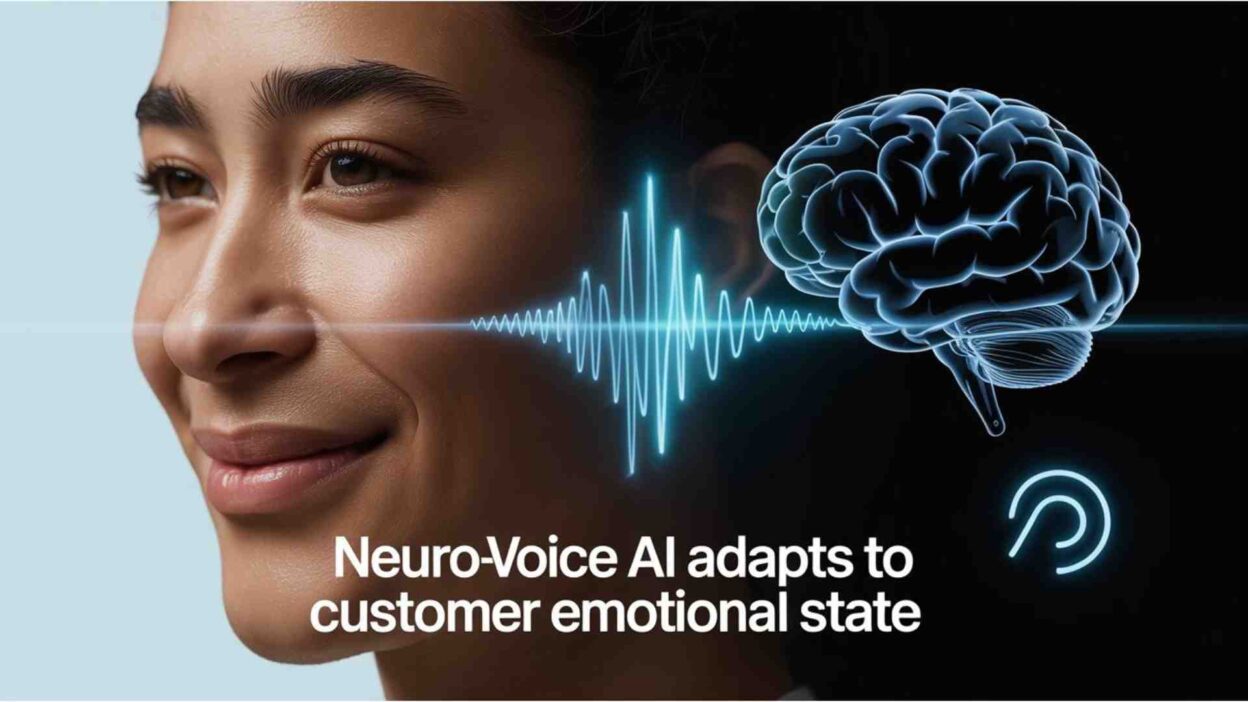TL;DR Neuro-voice AI technology transforms customer service by instantly recognizing and responding to emotional states during conversations. This revolutionary artificial intelligence system analyzes vocal patterns to detect frustration, happiness, anger, or calmness in real-time. Adaptive AI communication capabilities enable personalized responses that match customers’ emotional needs perfectly.
Table of Contents
Understanding Neuro-Voice AI Technology
Neuro-voice AI represents breakthrough technology that combines neuroscience principles with advanced artificial intelligence capabilities. These systems analyze multiple voice characteristics, including pitch, tone, volume, and speech cadence patterns. Machine learning algorithms process vocal data to identify specific emotional states within milliseconds.
The technology uses sophisticated neural networks trained on massive datasets of human emotional expressions. Voice pattern recognition enables accurate identification of subtle emotional nuances that humans might miss. Emotion detection in voice AI uses advanced algorithms to identify emotions from speech by analyzing vocal cues like tone and speed.
How Emotional Recognition Works
Advanced algorithms examine vocal biomarkers that indicate specific emotional states during customer interactions. Neuro-voice AI systems detect micro-expressions in speech that reveal underlying customer feelings. Pitch variations, speaking rate changes, and voice quality fluctuations provide emotional intelligence data.
Real-time processing allows immediate emotional state identification without conversation delays or interruptions. Emotion detection in voice AI analyzes various characteristics of speech, such as pitch, tone, volume, and cadence, to identify emotions like anger, frustration, happiness, or calmness. Machine learning models continuously improve accuracy through exposure to diverse emotional voice patterns.
Neural Network Processing Capabilities
Deep learning networks process complex voice data patterns to extract emotional intelligence from customer conversations. Neuro-voice AI systems use multiple neural network layers for comprehensive emotional analysis. Each processing layer identifies different aspects of emotional expression within voice communications.
Pattern recognition algorithms distinguish between genuine emotions and artificial or forced emotional expressions. Adaptive AI communication technology learns from each interaction to improve future emotional recognition accuracy. Neural networks adapt to individual voice characteristics while maintaining consistent emotional detection capabilities.
Benefits of Adaptive AI Communication
Adaptive AI communication technology provides personalized customer experiences that match individual emotional needs and preferences. Customer satisfaction increases dramatically when AI systems respond appropriately to emotional states. Service quality improves through emotionally intelligent responses that demonstrate understanding and empathy.
Enhanced Customer Experience
Personalized communication approaches reduce customer frustration while improving problem resolution efficiency and effectiveness. Neuro-voice AI adapts conversation style, pace, and tone based on detected emotional states. In real-time, emotional AI can analyze a customer’s tone, language, and emotional cues. For example, if a customer sounds frustrated, the system can respond accordingly.
Emotionally aware responses create stronger connections between customers and AI systems during service interactions. Customer loyalty increases when people feel understood and heard by artificial intelligence platforms. Adaptive AI communication eliminates the cold, robotic feeling often associated with traditional automated systems.
Reduced Escalation Rates
Emotional intelligence prevents minor issues from escalating into major customer service problems through appropriate responses. Adaptive customer service bots can sense frustration and pass the call to a human employee quickly, leading to a more positive experience through query resolution. Early intervention based on emotional cues prevents customer dissatisfaction before it becomes problematic.
Proactive emotional support reduces the need for human agent intervention in routine customer service situations. Neuro-voice AI systems handle emotionally charged situations with greater sensitivity than traditional automated responses. Customer retention improves when emotional needs receive appropriate attention and care.
Real-World Applications and Implementation
Companies across various industries implement neuro-voice AI technology to improve customer service quality and operational efficiency. Healthcare organizations use emotional recognition to provide compassionate patient support during stressful medical situations. Financial services leverage adaptive AI communication to handle sensitive conversations about money and personal finances.
Industry-Specific Use Cases
Call centers achieve significant improvements in customer satisfaction scores through neuro-voice AI implementation. Customer service centers use emotion AI to detect caller frustration and guide service representatives toward more empathetic responses, leading to faster problem resolution. Retail businesses create personalized shopping experiences that adapt to customers’ emotional states during purchasing decisions.
Healthcare providers use emotional recognition technology to identify patient anxiety and provide appropriate reassurance. Educational institutions implement adaptive AI communication to support students experiencing academic stress or emotional difficulties. Government agencies utilize neuro-voice AI to handle citizen concerns with appropriate sensitivity and understanding.
Performance Metrics and Results
Organizations report substantial improvements in customer satisfaction scores after implementing neuro-voice AI technology. First-call resolution rates increase when AI systems respond appropriately to customer emotional states. Average handling time decreases while maintaining higher quality interactions and customer experiences.
Customer retention rates improve significantly when businesses deploy emotionally intelligent AI systems. Net Promoter Scores increase as customers appreciate empathetic and understanding service interactions. Adaptive AI communication technology delivers measurable business benefits alongside improved customer experiences.
Technical Architecture and Components
Neuro-voice AI systems require sophisticated technical infrastructure to process emotional data in real-time during conversations. Advanced microphone arrays capture high-quality audio data for accurate emotional analysis and recognition. Cloud-based processing power enables complex neural network computations without latency issues.
Data Processing Pipeline
Audio preprocessing systems filter background noise and enhance voice quality for optimal emotional recognition accuracy. Feature extraction algorithms identify relevant voice characteristics that indicate specific emotional states. Neuro-voice AI platforms use multi-layer neural networks for comprehensive emotional pattern analysis.
Real-time processing capabilities ensure emotional recognition occurs without noticeable delays during customer conversations. Adaptive AI communication systems integrate with existing customer service platforms through standardized APIs. Machine learning models update continuously based on new emotional data and interaction outcomes.
Integration Requirements
Modern customer service platforms integrate neuro-voice AI technology through cloud-based APIs and software development kits. Existing phone systems require minimal modifications to support emotional recognition capabilities and advanced features. Security protocols protect sensitive emotional data while enabling effective AI processing and analysis.
Quality assurance systems monitor emotional recognition accuracy and provide feedback for continuous improvement. Adaptive AI communication platforms offer dashboard interfaces for monitoring emotional intelligence performance metrics. Integration testing ensures neuro-voice AI systems work seamlessly with existing business applications.
Advanced Features and Capabilities
Modern neuro-voice AI systems offer multilingual emotional recognition capabilities for global customer service operations. Cultural sensitivity features adapt emotional interpretation to different regional communication styles and preferences. Advanced sentiment analysis provides detailed emotional intelligence beyond basic emotional state identification.
Predictive Emotional Analytics
Machine learning algorithms predict potential emotional escalation before it occurs during customer interactions. Proactive intervention strategies prevent negative emotional experiences through early warning systems and appropriate responses. Neuro-voice AI systems learn individual customer emotional patterns for personalized service approaches.
Historical emotional data analysis helps businesses understand customer emotional trends and service improvement opportunities. Predictive models identify customers at risk of emotional distress based on voice pattern analysis. Adaptive AI communication technology enables preemptive customer support before problems become serious issues.
Continuous Learning Mechanisms
Neural networks adapt to new emotional expressions and cultural variations through continuous learning processes. Feedback loops improve emotional recognition accuracy based on actual customer interaction outcomes and results. Neuro-voice AI systems evolve their understanding of human emotions through exposure to diverse customer populations.
Machine learning models incorporate customer feedback to refine emotional recognition algorithms and improve performance. Adaptive AI communication platforms update their responses based on successful emotional intervention strategies. Continuous improvement ensures neuro-voice AI technology remains effective across changing customer demographics and expectations.
Future Developments and Innovations
Emerging technologies will enhance neuro-voice AI capabilities through integration with facial recognition and biometric monitoring systems. Virtual reality integration will create immersive customer service experiences that respond to comprehensive emotional intelligence data. Advanced personalization will enable AI systems to remember individual customers emotional preferences across multiple interactions.
Next-Generation Emotional Intelligence
Quantum computing may revolutionize neuro-voice AI processing capabilities through unprecedented computational power and analysis speed. Brain-computer interfaces could provide direct emotional data input for more accurate AI emotional understanding. Multi-modal emotional recognition will combine voice, facial, and physiological data for comprehensive emotional intelligence.
Adaptive AI communication technology will become more sophisticated through integration with Internet of Things devices. Smart home systems could provide contextual emotional data to enhance customer service interactions. Wearable technology integration will offer additional emotional intelligence data for more accurate customer understanding.
Industry Transformation Potential
By 2025, AI is expected to handle up to 95% of customer interactions across voice and text. Neuro-voice AI will become standard technology for customer service operations across all industries. Emotional intelligence capabilities will differentiate leading companies from competitors in customer experience delivery.
Regulatory frameworks will evolve to address privacy concerns while enabling beneficial emotional AI applications. Ethical guidelines will ensure neuro-voice AI technology serves customer interests while protecting personal emotional data. Industry standards will emerge for emotional recognition accuracy and appropriate response protocols.
Implementation Best Practices
Organizations should begin neuro-voice AI implementation with pilot programs to test effectiveness and gather performance data. Staff training programs help employees understand how emotional AI enhances their customer service capabilities. Change management strategies ensure a smooth transition to emotionally intelligent customer service operations.
Deployment Strategies
Gradual rollout approaches allow businesses to refine neuro-voice AI systems based on real-world performance and feedback. Integration with existing customer service workflows minimizes disruption while maximizing emotional intelligence benefits. Performance monitoring systems track emotional recognition accuracy and customer satisfaction improvements.
Privacy protection measures ensure customer emotional data remains secure while enabling effective AI processing. Adaptive AI communication systems require clear policies regarding emotional data usage and storage practices. Transparency initiatives help customers understand how emotional recognition enhances their service experience.
Success Measurement Criteria
Key performance indicators should include emotional recognition accuracy rates alongside traditional customer service metrics. Customer satisfaction scores provide direct feedback on neuro-voice AI effectiveness and emotional intelligence quality. Resolution time improvements demonstrate operational benefits of emotionally aware customer service systems.
Employee satisfaction metrics indicate how neuro-voice AI technology supports customer service representatives in their work. Return on investment calculations should include emotional intelligence benefits alongside cost savings and efficiency improvements. Long-term customer loyalty measurements demonstrate sustained value from adaptive AI communication technology.
Read More: Transforming Business Growth With AI Automated Calling Systems
Conclusion

Neuro-voice AI technology represents a transformative advancement in customer service through real-time emotional state recognition and appropriate responses. This innovative artificial intelligence capability creates personalized customer experiences that demonstrate genuine understanding and empathy. Adaptive AI communication systems bridge the gap between automated efficiency and human emotional intelligence.
The technology delivers substantial business benefits including improved customer satisfaction, reduced escalation rates, and enhanced operational efficiency. Organizations implementing neuro-voice AI gain competitive advantages through superior customer experience quality and emotional intelligence capabilities. Future developments will continue expanding the potential applications and effectiveness of emotionally aware AI systems.
Investment in neuro-voice AI technology positions businesses at the forefront of customer service innovation and emotional intelligence advancement. Companies adopting adaptive AI communication demonstrate a commitment to understanding and serving customers’ emotional needs effectively. The transformation toward emotionally intelligent AI represents the future of customer service excellence and business success.





